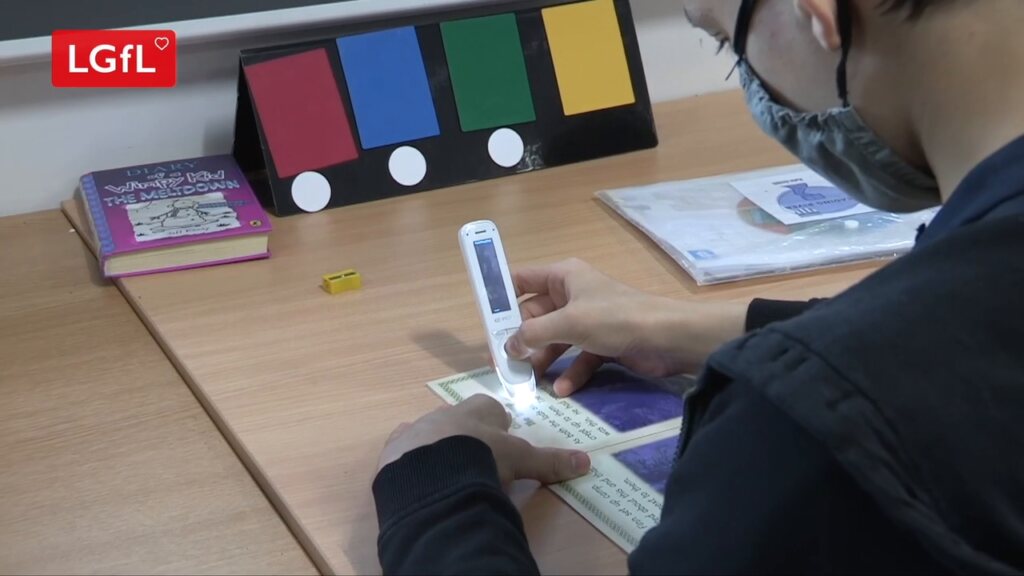Augmentative & alternative communication
"Adapt the tools and strategies you already use to enable the pupil to access language surrounding death and grief."
Augmentative and Alternative Communication (AAC) can be a vital tool in communicating with bereaved pupils and exploring their grief. It is important to start by using strategies and resources that you know work with the pupil and are familiar to them. The AAC system that is used may need adapting to include language related to death. This could include the words ‘dead’, ‘died’ or ‘funeral’. These words may need to be explicitly taught before they can be used. There may be useful words/symbols/signs which are already known by the pupil, such as ‘sad’, ‘angry’, ‘remember’, ‘cry’, but it could help to specifically link these to the expression of feelings around grief. Depending on the communication system, you may consider grouping some of these words together so that if the pupil wants to talk about the bereavement or express their grief, they can indicate this more easily. Work with the pupil’s speech and language therapist to ensure the best approach for the individual pupil.
To maintain consistency between school and home, inform parents/carers about any adaptations you have made so that they can use the same words/symbols/signs.
Further links:
Stories, books and toys
"They might use toys to act out what might have happened…it can help the adults working with them to know if there are any misconceptions around what has happened."
To further understand the reality of the death some pupils may find it useful to ‘act out’ what has happened. This could be drawing pictures of the event or using dolls to replay the funeral and ongoing process of grief.
Using toys can help engage a pupil and aid an adult in communicating complex or unfamiliar concepts.
Some pupils may find it easier to express how they are feeling by using a book. Stories and films may provide relatable characters and experiences to help them explore their own grief. There are a range of books and resources around the theme of bereavement so it may be useful to try different approaches and find one to suit the individual.
More information can be found here:
Repetition
"This repetition is a really important part of that pupil’s learning journey into understanding death."
It can be difficult for staff to have repeated conversations about loss, death, and grief, especially if there has been a death in the school community that has affected them. However, children with additional needs may need a death to be explained multiple times. It could be that they need reminding that death is permanent and that the person is not coming back. It could be that they are fixating on a particular detail and need repeated reassurance over a specific anxiety. Some pupils may ask the same question repeatedly, so having a consistent response from everyone around them will help.
Adults in school can help families with these repeated explanations. For members of staff, it is important to recognise when you may need support from a colleague and to refer the pupil to another trusted adult using visual or other non-verbal prompts.
The need for repetition is often due to the pupil needing reassurance or to process the death, and it is best to maintain a consistent approach to what and how you are communicating with them.
Further links:
Multi-sensory
"...a multi-sensory approach can be a really good way of helping to recreate some of their memories."
You may be supporting a pupil with multi-sensory impairment or someone who has sensory needs. Consider these when helping them to understand more about death and grief. It could be that you use physical objects to help them understand the difference between living and dead. This could be touching some flowers/plants that are growing and then touching some that are dried up and dead.
Smell is very closely associated with our memories. It could be that you create a memory box that includes items, with smells connected to the person who has died. Perhaps this could be a perfume they wore or maybe some coffee grounds if that was a drink they liked.
Music can be used in many ways to support someone who is bereaved. The pupil may express feelings of anger by banging a drum or find a piece of music soothing when they are having an emotional reaction. They also may associate specific songs with the person who has died.
A multi-sensory approach that is adapted to the individual pupil will help to develop their understanding of what is happening and how they are feeling.
Personal interests
"Think about what the pupil likes and what is interesting to them..."
When working with bereaved pupils, it can help to engage with their personal interests to help them to navigate difficult topics such as death and grief.






